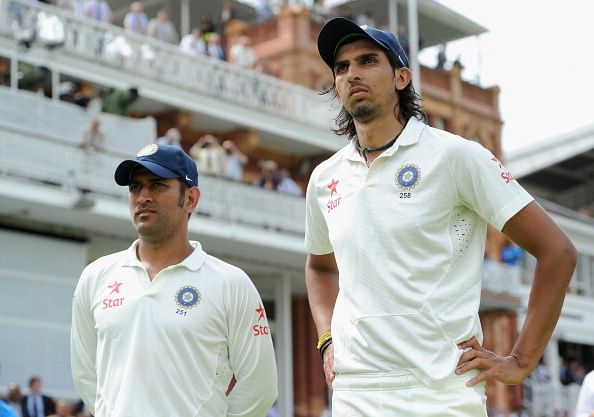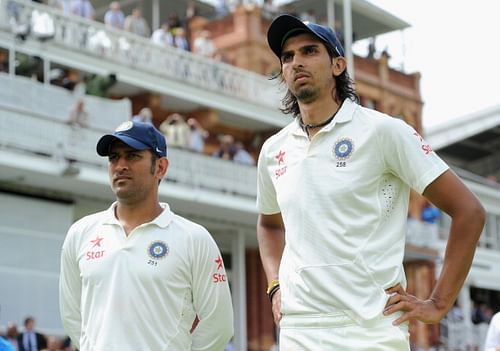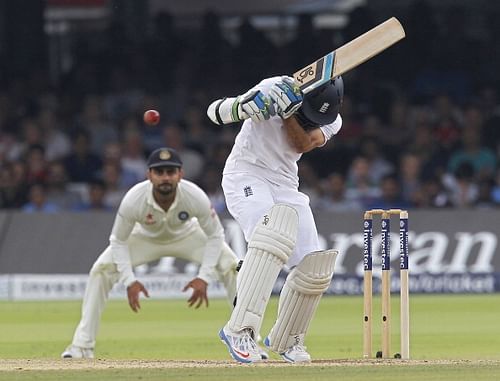
Mahendra Singh Dhoni: When the usually cool captain turned persistent

“The mettle of a man is tested in adversities and he, who remains firm in his beliefs, comes out shining.” - Samaveda
Misery away from home
It was on July 21, 2011, during a somber afternoon at Lord’s that India’s woes commenced. Zaheer Khan clutched his hamstring and limped off the plush-looking outfield, down that famous slope, leaving Mahendra Singh Dhoni stranded for options. With his limited and ever dwindling resources at disposal, Dhoni made every attempt feasible to knock a motivated, and at the time a forcefully ascending English side down. But his efforts brokered no reward. India left England winless, and then brought that awful form to Australia. During the course of these two series, injuries, and then retirements, kept piling. At home, the injection of fresh blood instilled a sense of optimism, albeit for a brief period.
And then there were the abridged tours to South Africa and New Zealand. A young Indian team, with Dhoni still at the helm, showed they could stand up to the might of the most potent attack in the world, and that they could compete in conditions mildly alien. Yet, the results failed to provide evidence of the same. A counter was loosely maintained on social media, by several aficionados of the sport, reflecting the number of days since India last won a Test match away from the safe confines of home: 219 days, it read, after the series against Australia in 2011-12. By the time India returned from South Africa in the December of 2013, it had been a whopping 921 days, and the New Zealand series that soon followed propelled the number to 971.
Today marks 1,000 days since India last won an away Test match.
— Alternative Cricket (@AltCricket) March 19, 2014
Calm amidst the storm
Through it all, Dhoni endured the ire of pundits and armchair critics alike with customary composure. The interest of the team was always at the fore. "At the end of the day, you want India to perform. If there is someone who can do a better job, then it's a place that should be given to him. It's not something you have to cling on to," he said, when he was relentlessly asked if he was the right man to lead India. He was backed by Sachin Tendulkar, Rahul Dravid and VVS Laxman, even after the three bid adieu. In turn, he continued to back the players he placed his endless faith in, despite the outrage that often filtered in after any loss.
At times, Dhoni couldn’t realistically defend such players, yet he seldom refrained. When they delivered, he could be ecstatic. “He is one of the most god-gifted talents that is around,” he said of Rohit Sharma, when the latter paved way for an Indian win against England in a One-Day International after a string of insipid scores.
It was Dhoni who insisted Rohit be promoted in the batting order, making it known to him, and the management, in no uncertain terms that he possessed the ability to open the batting and counter the new ball. The same experts who previously slammed Dhoni for being rigid in his selections turned around to admire his ‘team combination’, some going as far as to credit Dhoni for ‘resurrecting’ Rohit’s career. By now, though, Dhoni was used to such oscillating opinions engulfing him.
The tables finally turn
A month before the ongoing series against England, expectations on this Indian team had been down to a bare minimum, and into the realms of reality, primarily owing to what transpired three years ago. Moreover, the selection didn’t cater to most, which is often the case, but an overwhelming majority could not fathom the presence of two names in the lineup — Rohit, and most notably, Ishant Sharma. ‘Why was Ishant picked over Umesh Yadav?’ This was one of the most common headlines used in many an article, and honestly, it was an understandable question.
After the first Test at Trent Bridge ended quite soporifically, India’s winless streak away from home had stretched to 1116 days, and one reckoned it was the best India could do in this leg of the tour, for they wouldn’t find a friendlier turf going forward. And surely enough, a green top — one that was difficult to distinguish from the finely cut strip of grass alongside it — presented itself for the fixture at Lord’s, a nightmare for most sub-continent sides. Worse, the Indians were asked to bat first. They slumped to 145 for seven, but the lower-order, as has been the norm in this series thus far, fought back.
With 295 in the first innings, Bhuvneshwar Kumar — easily the best performer of the season so far — took six scalps to restrict England to a lead of 24. Murali Vijay and Ravindra Jadeja then drove home the advantage on what was by now a less than menacing wicket. A target of 319 was always a daunting one in the fourth innings, but England had ample time and ammunition at its service.
At 173 for four, a ball before the lunch interval, the Indians were far from favourites. Bowlers’ efforts rendered futile, but then Dhoni wanted the man under the scanner for last few years — Ishant — to pitch it short. Ishant was hesitant, and Dhoni persistent. In the end, the captain passed his order and walked away. “To start off with, it was very difficult to convince him [Ishant]," Dhoni said. "When he first came on to bowl, I asked him to bowl short, and he turned the other way. Then I set the field for him so that he couldn't even think of bowling up. So the strategy was to give him a field so he is forced to bowl the length that I wanted him to bowl,” Dhoni later confessed.
The lanky speedster ran in characteristically, his relatively shortened hair swaying, and took the stoic Moeen Ali by surprise with a bouncer that jumped awkwardly, half because the batsman perhaps failed to anticipate it.

The dismissal bolstered both Ishant and India. In his next few overs, Ishant took five more wickets, with five short balls. By the time England lost nine wickets, and were a hundred runs away from the target, Ishant had bagged seven for 74, his spell now part of folklore at the Mecca of cricket. Agreed, he put in the hard yards, banged the soft ball hard and flummoxed almost the entire English lineup, but would it have come to this, a victory at Lord’s after 28 years, had the captain not taken a firm stance?
“I think all these wickets are not for me, it is for the captain. He told me, 'you are tall enough, you have to bowl the bouncer,' that's what I did and it worked for me," Ishant said after collecting his man-of-the-match award.
Exactly three years after the horrendous run commenced, on July 21, 2014, the counter will come to a halt. It’s refreshing to know that a captain, who was rebuked for the entirety of these last three years, has engineered an Indian victory at where it all started, and on what is perhaps the biggest stage in the Test arena. This may not indicate a lasting change in his modus operandi, or even that the Indian team may have turned a corner. One swallow certainly does not make a summer, but it’s only right that the plan he’s etched under trying circumstances, and later insisting that his bowler follow through, be duly applauded. For if India had conceded to England what would have been the second highest run chase at the venue, would voices demanding his ouster not have grown? Dhoni’s mettle was tested, and he did come out shining.